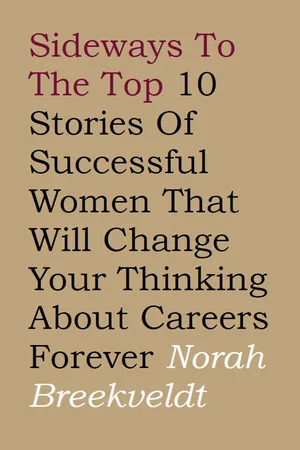
Sideways to the Top
10 Stories of Successful Women That Will Change Your Thinking About Careers Forever
Norah Breekveldt
- 292 pages
- English
- ePUB (mobile friendly)
- Available on iOS & Android
Sideways to the Top
10 Stories of Successful Women That Will Change Your Thinking About Careers Forever
Norah Breekveldt
About This Book
Sideways to the Top is a thought provoking book that explores how 11 women challenged the status quo and took alternative career pathways to the top. The 10 case studies challenge many of the generalisations and stereotypes about how women achieve success, told through the stories of a diverse range of women leaders, including some seen as Australian icons and others with lower profiles who nonetheless have achieved a great deal. The book also features:
- Chapters about the realities and current issues facing women building their careers, linking useful ideas and tools with the realities of those whose stories are told.
- An example of how one multinational corporate is changing the culture and mindset in the business towards accepting diversity as a business imperative.
- A practical checklist and action plan to help women navigate their career.
Frequently asked questions
Information
Catherine Nance

- In 2009, American women outnumbered men in the workforce for the first time.
- They now outnumber men on degree courses by a ratio of three-to-two, and are even beginning to ‘crowd out men’ in science and engineering courses.
- More and more families depend on the woman as the main breadwinner (almost 64 percent in Washington, DC).
- Of the 15 most expanding job categories in the US, 12 are now dominated by women.
- As at October 2012, women comprise 35 percent of the workforce.2
- In August 2011, 59 percent of women were in the labour force, and their participation rate is steadily increasing each year. By contrast, 82 percent of men were in the labour force and their participation rate has been declining.3
- Women graduates have outnumbered men on degree courses since the 1980s (a steady 51 percent of women were graduates from 1988 to 1992).4 By 2011, 57 percent of higher education students were women.5
- In 2011, women outnumbered men two-to-one in management and commerce degrees.6
- Eighty percent of purchases or purchasing decisions are made by women.7
- Women live longer than men. A boy born in 2009 to 2011 can expect to live to almost 80 years, while a girl can expect to live just over 84 years.8
- Only six percent of line management positions in the ASX 200 are held by women (the pipeline to many CEO roles).
- There are only seven female CEOs in the ASX 200 (up from six in 2010).
- Women still hold only 12 percent of ASX 200 directorships and only 9.7 percent of executive roles.
- Fifty-six percent of ASX 500 companies still do not have a woman on their boards.9
- Australia is ranked 50th in the world for women’s workforce participation relative to men’s.10
- In Australia, at the time of writing, we currently have a woman prime minister, governor-general and speaker in Parliament.
- For over 20 years, we have had women premiers in every state and territory in Australia except South Australia.
- In 2012, women made up 24.7 percent of elected positions in the House of Representatives and 38.2 percent of the senate.12
- At June 2011, women comprised 57.5 percent of all Australian Public Service employees13 and held 35.3 percent of government board appointments, with four government portfolios meeting the gender-balance target.14
‘How is our workforce developing, and what will it look like in the foreseeable future?’
‘I think ageism will have to vanish through sheer weight of numbers. I think that discrimination towards women will also vanish.’
- Higher participation rates among women.
- Increases in the age pension requirement, with the age for women increasing to 65.5 by mid-2017, followed by the age for both women and men rising to 67 by mid-2023. increasing the participation of older workers in the labour market.
- Shifts in traditional attitudes to retirement, as Australians adjust to significant increases in longevity.21
‘Once we’ve all slipped towards the 50 and over [age bracket], we’re sort of slipping off the radar.’
- Lockheed Martin, an American global aerospace, defence, security and advanced technology company, were able to demonstrate that the costs associated with retaining older workers, including retraining and the redesign of jobs, tools and practices, can be offset through improved performance, lower claims and reduced medical costs. Retaining older workers is also likely to assist in the transmission of highly desirable work traits, such as loyalty and a strong work ethic, from older to younger workers.23 Older employees are also often custodians of a large amount of corporate knowledge and have strong industry networks, both highly valuable to employers and difficult to replicate in younger employees.
- Research conducted in the US in 2010 found that the greatest productivity loss occurs in employees aged in their 30s, whereas productivity loss occurs least in employees aged 60 or older.24
- Other research into Nobel Prize winners and great inventors found that innovators are around six years older today than they were a century ago. This shift, the researchers concluded, is consistent with the life-cycle productivity of great minds (this increases as they get older) and is also consistent with an ageing workforce.25
- Finally, the average founder of a high-tech startup isn’t a whiz-kid graduate, but a mature 40-year-old. Older entrepreneurs have higher success rates when they start companies and the highest rate of entrepreneurship in America has shifted to the 55–64 age group, with people over 55 almost twice as likely to found successful companies than those between 20 and 34.26
- Australia, and indeed many countries worldwide, are facing talent shortages, which will only worsen. We will need older people to work because we won’t have enough workers otherwise.
- McKinsey reported that, by 2040, Europe will have a shortfall of 24 million workers aged 15 to 65. This gap can be reduced to three million if the p...
Table of contents
- Contents
- Introduction
- Acknowledgments
- Contemporary Research Findings
- Dr Hannah Piterman, Contemplations on a 30-year Journey
- Dr Kerry Baxter, Against the Odds
- 10 Inspirational Stories of Career Success
- Katie Lahey, Grab that Opportunity
- Ann Sherry, AO, Career Hopscotch
- Women in Partnership: Yin–Yang Balance
- Theresa Gattung, Cracking the Glass Ceiling
- Terri Janke, Driven by a Vision
- Naomi Simson, Rebel with a Cause
- Janine Allis, You’ve Come a Long Way, Baby
- Farah Farouque, You’ve Come a Long Way, Baby
- Jane Fenton, AM, You’ve Come a Long Way, Baby
- Annwyn Godwin, A Public–Private Partnership
- Reflections and Conclusions
- Catherine Nance, The Future of Work: A Woman’s Perspective
- Heather Carmody, The Gloves are Off in the Diversity War
- Paul Waterman, Engaging the Head and the Heart
- Katherine Teh-White, The Secret to Career Happiness
- Kathleen Townsend, What the Headhunters Don’t Tell You
- Hugh Davies, Drawing Some Conclusions about Career Management in the Current Decade
- A Checklist for Successful Career Navigation
- Action Plan
- Footnotes
- Additional Reading